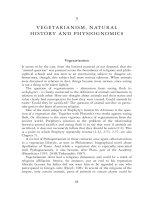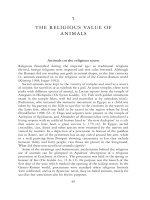animals cranes and stork
Bạn đang xem bản rút gọn của tài liệu. Xem và tải ngay bản đầy đủ của tài liệu tại đây (5.22 MB, 49 trang )
by Steven Otfinoski
animalsanimals
MCC-Animals Animals 10 - Cranes and Storks_27078
PL209-9 / 4269
Final Cranes INT_.qxd 2/10/09 8:03 AM Page 1
Thanks to Donald E. Moore III, associate director of animal care at the Smithsonian Institution’s National Zoo,
for his expert reading of this manuscript.
Marshall Cavendish Benchmark
99 White Plains Road
Tarrytown, New York 10591-5502
www.marshallcavendish.us
Text copyright © 2010 by Marshall Cavendish Corporation
All rights reserved. No part of this book may be reproduced or utilized in any form or by any means, electronic
or mechanical, including photocopying, recording, or by any information storage and retrieval system, without
permission from the copyright holders.
All websites were available and accurate when this book was sent to press.
Library of Congress Cataloging-in-Publication Data
Otfinoski, Steven.
Cranes and Storks / by Steven Otfinoski.
p. cm. — (Animals animals)
Includes index.
Summary: "Provides comprehensive information on the anatomy, special
skills, habitats, and diet of cranes and storks"—Provided by publisher.
1. Storks—Juvenile literature. 2. Cranes (Birds)—Juvenile literature.
I. Title.
QL696.C535O84 2009
598.3'2—dc22
2008020913
Photo research by Joan Meisel
Cover photo: Tom Vezo/Minden Pictures
The photographs in this book are used by permission and through the courtesy of:
AP Images: 38, 39. Alamy: franzfoto.com, 10, 32; Arco Images GmbH, 11; Gary Dublanko, 14.
Animals Animals - Earth Scenes: Studio Carlo Dani, 27; Mark J. Barrett, 36. Corbis: Theo Allofs, 1; Arthur Morris, 4, 33;
Steve & Ann Toon/Robert Harding World Imagery, 6; Franz Lanting, 22; Uwe Walz, 30; Raymond Gehman, 34;
Jeff Vanuga, 37. Getty Images: Roy Rainford, 7; altrendo images, 8; Panoramic Images, 12; DAJ, 17;
Heinrich van den Berg, 28. Minden Pictures: Winfried Wisniewski, 18; Tim Fitzharris, 20; David Pike, npl, 23;
Barry Mansell, 25. Peter Arnold Inc.: Biosphoto/Denis-Huot Michel & Christine, 16.
Photo Researchers, Inc.: Millard H. Sharp, 9.
Editor: Joy Bean
Publisher: Michelle Bisson
Art Director: Anahid Hamparian
Series Designer: Adam Mietlowski
Printed in Malaysia
1 3 5 6 4 2
MCC-Animals Animals 10 - Cranes and Storks_27078
CPL409-35 / 4269
Final Cranes INT_.qxd 4/8/09 11:32 AM Page 2
ISBN 978-0-7614-4508-1
Contents
1 Beauty on the Wing 5
2 Avid Eaters 15
3 Faithful Parents 21
4 Long-distance Fliers 29
5 Storks, Cranes, 35
and People
Glossary
40
Find Out More 42
Index 44
MCC-Animals Animals 10 - Cranes and Storks_27078
PL209-9 / 4269
Final Cranes INT_.qxd 2/10/09 8:03 AM Page 3
MCC-Animals Animals 10 - Cranes and Storks_27078
PL209-9 / 4269
Final Cranes INT_.qxd 2/10/09 8:03 AM Page 4
5
1
Cranes are well known for being good parents. Here, two crane chicks
rest on their mother’s back.
Beauty on
the Wing
On land or in the air, few birds are as graceful as
storks and cranes. These tall birds have fascinated
people for centuries. They are characters in folklore,
legend, and myth. Many peoples consider them a sign
of good fortune. And people around the world tell the
story of the stork bringing human babies to lucky
couples. Of course storks do not really deliver babies
to couples. This legend probably began because
storks (and cranes, too) are such loving parents to
their own babies.
Storks and cranes are not in the same animal fami-
ly, but they are often grouped together because they
share many physical characteristics. Both storks and
MCC-Animals Animals 10 - Cranes and Storks_27078
PL209-9 / 4269
Final Cranes INT_.qxd 2/10/09 8:04 AM Page 5
6
Storks and cranes look
very similar, but storks
have a longer bill than
cranes. This is a
saddle-billed stork.
cranes are large birds with long and slender legs, long
necks, and pointed beaks or bills. They are also both
wading birds. That means they spend much of their
time walking in the shallow waters of streams, ponds,
and marshes, or in nearby grasslands. Even though
storks and cranes both have wings, these birds spend
far more time on land and in water than in the air.
MCC-Animals Animals 10 - Cranes and Storks_27078
PL209-9 / 4269
Final Cranes INT_.qxd 2/10/09 8:04 AM Page 6
Cranes are taller than storks. This
is a sandhill crane.
With all things they have in common, you might
have a hard time telling a stork and a crane apart.
But there are a few differences. Cranes are generally
taller than storks, and they have longer necks.
Another difference between the two is that storks’
bills are longer and heavier than the bills of cranes.
Also, cranes fly with their necks outstretched, while
storks fly with their necks pulled in.
7
MCC-Animals Animals 10 - Cranes and Storks_27078
PL209-9 / 4269
Final Cranes INT_.qxd 2/10/09 8:04 AM Page 7
8
◆ The white stork is the world’s best-known stork.
It lives in Europe, Asia, and Africa. It stands 3
feet (1 meter) tall and is white in color with black
markings on its wings. It has a red beak and
reddish-pink legs and feet. The white stork
migrates to central Africa and northern India in
the winter.
Species Chart
A white stork.
MCC-Animals Animals 10 - Cranes and Storks_27078
PL209-9 / 4269
Final Cranes INT_.qxd 2/10/09 8:04 AM Page 8
9
A wood stork adult
and chick.
◆ The wood stork is the only stork native to the
United States. It is 4 feet (1.2 m) tall and has a
wingspan of 5.5 feet (1.7 m). It weighs about 4.5
to 5.8 pounds (2 to 2.6 kilograms). The wood
stork is white with black markings on its wings
and tail feathers. It lives in the swamps of Florida
and Georgia, as well as the coastal areas of
Central and South America.
MCC-Animals Animals 10 - Cranes and Storks_27078
PL209-9 / 4269
Final Cranes INT_.qxd 2/10/09 8:04 AM Page 9
10
◆ The whooping crane is the tallest bird in North
America. It stands up to 5 feet (1.5 m) tall and
has a wingspan of 6 to 7 feet (1.8 to 2.1 m). It
weighs 13.3 to 17 pounds (6 to 7.7 kg). The
whooping crane is white with black feathers on its
wing tips. It has red skin on its forehead and
cheeks. It lives most of the year in northern Canada
and flies to Texas’s Gulf Coast in the winter.
A whooping crane.
MCC-Animals Animals 10 - Cranes and Storks_27078
PL209-9 / 4269
Final Cranes INT_.qxd 2/10/09 8:04 AM Page 10
11
A black crowned crane.
◆ The black crowned crane is named for its colorful
yellow crest—or feathers atop its head—and its
black body. It is 3 feet (1 m) tall and has a
wingspan of 6 to 7 feet (1.8 to 2.1 m). It weighs
about 8.5 pounds (3.8 kg). The female has a
smaller crest than the male. The black crowned
crane lives in northeast and northwest Africa.
MCC-Animals Animals 10 - Cranes and Storks_27078
PL209-9 / 4269
Final Cranes INT_.qxd 2/10/09 8:04 AM Page 11
12
One of the easiest ways to tell cranes and storks
apart is to listen to them. The crane has a loud voice
and its noises can be heard up to a mile away. The
stork, on the other hand, cannot vocalize. The only
noise it makes is when it communicates with other
birds by clattering its bill.
There are nineteen species, or kinds, of storks.
Sixteen of them live in the Eastern Hemisphere. Just
three of the species live in the Western Hemisphere,
which includes North and South America. There are
A stork takes flight above a field.
Did You Know . . .
The black crowned crane
and its cousin, the grey
crowned crane, are the
only cranes that make their
nests in trees.
MCC-Animals Animals 10 - Cranes and Storks_27078
PL209-9 / 4269
Final Cranes INT_.qxd 2/10/09 8:04 AM Page 12
fifteen species of cranes. Thirteen of them live in
Europe, Africa, and Asia. Only two species live in
North America.
All storks have partially webbed feet with four
toes. Cranes have three toes on each foot. Both birds’
long, thin legs are perfect for wading in water. Their
pointed beaks are designed to catch or spear fish and
other animals in the water.
When these birds take to the air in flight, it is a
spectacular sight. They seem to barely flap their long,
spreading wings, but they glide through the air
almost effortlessly.
MCC-Animals Animals 10 - Cranes and Storks_27078
PL209-9 / 4269
Final Cranes INT_.qxd 2/10/09 8:04 AM Page 13
MCC-Animals Animals 10 - Cranes and Storks_27078
PL209-9 / 4269
Final Cranes INT_.qxd 2/10/09 8:05 AM Page 14
15
2
This yellow-billed stork has caught a large fish in the water.
Avid Eaters
The shallow waters where storks and cranes wade
provide them with most of their food. Black storks
and wood storks walk around slowly and patiently,
looking down into the water for food. Some stir up
the water with one foot. This causes fish or other sea
creatures to move about.
When the black stork sees a fat frog or a plump
fish swimming by, it will stand as still as a statue.
When its prey is close enough, the bird moves with
lightning speed. It seizes the frog in its long open
beak, or spears the fish through its body with its
closed beak. Then it swallows its prey whole. Wood
storks do the same, but they use their sense of touch,
MCC-Animals Animals 10 - Cranes and Storks_27078
PL209-9 / 4269
Final Cranes INT_.qxd 2/10/09 8:05 AM Page 15
16
Both cranes and storks eat a variety of things. Here, a stork is
catching a frog.
not sight, to find their prey. Black storks will also eat
small birds and mammals, such as field mice.
The African and Asian openbill storks can grab
freshwater snails in their bent bill. Then they crush
the snail’s shell in the bill’s gap to get at the soft body
that is inside.
MCC-Animals Animals 10 - Cranes and Storks_27078
PL209-9 / 4269
Final Cranes INT_.qxd 2/10/09 8:05 AM Page 16
17
This crane is searching
for food in the grass
with some help from
its young.
Cranes and storks are omnivores and will eat
plants as well as animals and fish. They also like to
eat berries, acorns, and fruits. Some storks, such as
marabous, which are the largest storks, will even eat
dead animals they find. These storks serve a good
purpose by keeping the environment clean and stop-
ping the spread of disease from dead animals.
MCC-Animals Animals 10 - Cranes and Storks_27078
PL209-9 / 4269
Final Cranes INT_.qxd 2/10/09 8:05 AM Page 17
This flock of sandhill cranes is landing in a field
during migration.
18
A crane’s size will often determine the kind of
food it favors. Short-billed cranes will graze on grass
on solid ground and dig around for insects. Longer-
billed cranes will hunt for shellfish in shallow waters.
The biggest cranes have huge, powerful bills they use
to dig up roots to eat in wetlands.
Many storks and cranes are migratory birds. In the
winter they travel to warmer places where they can
find food. Whooping cranes live most of the year in
Did You Know . . .
Stork chicks can eat up
to 60 percent of their own
body weight each day. If
you weigh 80 pounds (36
kg), that would be like eat-
ing 48 pounds (22 kg) of
food every day.
MCC-Animals Animals 10 - Cranes and Storks_27078
PL209-9 / 4269
Final Cranes INT_.qxd 2/10/09 8:05 AM Page 18
19
northern Canada, but in the winter they travel several
thousands miles to the Gulf of Mexico near Texas.
During the long flight, the cranes call to each other
with loud bugle-like noises. That is how they got the
name “whooping cranes.” Scientists think they
whoop to keep track of each other during the long
migration south. Once on the warm Gulf Coast,
the cranes live on a diet of mostly crabs, clams, and
crayfish.
The white stork travels even farther than the
whooping crane in its annual migration. It flies from
Europe to Africa in the winter. This is a journey of
more than 6,000 miles (9,650 kilometers).
MCC-Animals Animals 10 - Cranes and Storks_27078
PL209-9 / 4269
Final Cranes INT_.qxd 2/10/09 8:05 AM Page 19
MCC-Animals Animals 10 - Cranes and Storks_27078
PL209-9 / 4269
Final Cranes INT_.qxd 2/10/09 8:05 AM Page 20
21
3
A white stork and its chicks sit in their nest on a rooftop.
Faithful Parents
Some people feel a special closeness with storks sim-
ply because some of them live so nearby. In Northern
Europe, for instance, white storks sometimes build
their nests on the roofs of houses, chimneys, walls,
and haystacks. The birds also build nests in trees,
cliff-ledges, and even on the ground.
Stork nests are among the largest nests in nature.
They can be 6 feet (1.8 m) across and as deep as 10
feet (3 m). Once a pair of storks build a nest that big,
they do not easily abandon it. Each year, white storks
return to the same rooftop nests. Sometimes two or
more stork couples nest on the same roof. Most peo-
ple who share their home with the storks welcome the
birds’ return in the spring.
MCC-Animals Animals 10 - Cranes and Storks_27078
PL209-9 / 4269
Final Cranes INT_.qxd 2/10/09 8:06 AM Page 21
22
Storks use sticks and plant stems to make sure the
nest is strong. They then line the nest with everything
they can find—from grass to feathers to bits of
cloth—to make it soft. By the time the nest is ready to
be used, the stork couple has mated several times and
the female is ready to lay her eggs.
Storks and cranes both build large nests and they need to find a lot a
material to build up those nests.
MCC-Animals Animals 10 - Cranes and Storks_27078
PL209-9 / 4269
Final Cranes INT_.qxd 2/10/09 8:06 AM Page 22
23
A pair of red-crowned
cranes do a courtship
dance.
Cranes build their nests in marshes and other wet-
lands, usually in quiet, hidden places where predators
will not disturb them or try to eat their eggs. Cranes
have a unique way of mating. They begin with a com-
plicated mating dance. The male and female cranes
circle each other, keeping their heads low and their
wings open. They leap and bound in the air as
they circle each other. Scientists do not yet fully
understand the meaning of the dance cranes do, or its
curious movements.
MCC-Animals Animals 10 - Cranes and Storks_27078
PL209-9 / 4269
Final Cranes INT_.qxd 2/10/09 8:07 AM Page 23
24
Female storks lay between two and six eggs in
their nests. They lay one egg every two days. Cranes
generally lay only two eggs. After mating, most male
birds leave the females, never to return. But not male
storks and cranes. They are faithful fathers, and they
share the work of caring for the eggs. People once
thought that storks mated for life and were monoga-
mous. After much study, however, scientists now
believe that these birds are serially monogamous.
This means they often find new mates after a season
or migration.
The male and female birds take turns sitting on
the eggs. This process of keeping the eggs warm until
they are ready to be hatched is called incubation.
After about thirty-three days, the baby storks and
cranes are ready to hatch. Breaking out of the tough
eggshell is hard work. The chicks use a hard knob at
the tip of their upper bill called an egg tooth. This
knob helps them break through the shell and emerge
from the egg. The egg tooth falls off the chick’s bill a
day or two after it hatches.
The first weeks of life are difficult for new stork
chicks. Cold weather, predators, and lack of food
cause several of them to die. The odds are even worse
MCC-Animals Animals 10 - Cranes and Storks_27078
PL209-9 / 4269
Final Cranes INT_.qxd 2/10/09 8:07 AM Page 24









